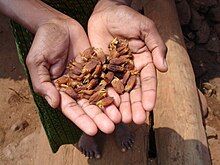

Non-timber forest products (NTFPs) are useful foods, substances, materials and/or commodities obtained from forests other than timber. Harvest ranges from wild collection to farming. They typically include game animals, fur-bearers, nuts, seeds, berries, mushrooms, oils, sap, foliage, pollarding, medicinal plants, peat, mast, fuelwood, fish, insects, spices, and forage.[1] Overlapping concepts include non-wood forest products (NWFPs),[2] wild forest products, minor forest produce,[3] special, minor, alternative and secondary forest products – for further distinctions see the definition section below
Research on NTFPs has focused on their ability to be produced as commodities for rural incomes and markets, as an expression of traditional knowledge or as a livelihood option for rural household needs, as a key component of sustainable forest management and conservation strategies, and for their important role in improving dietary diversity and providing nutritious food, particularly for forest-proximate peoples.[2] All research promotes forest products as valuable commodities and tools that can promote the conservation of forests.
NTFPs in particular highlight forest products which are of value to local people and communities, but have been overlooked in the wake of forest management priorities (for example, timber production and animal forage). For example, some 2.4 billion people – in both urban and rural settings – use wood-based energy for cooking.[4] Different communities are involved in collecting and using forest NTFPs, often with different minority communities or gender roles determining how they are used.
In recent decades, interest has grown in using NTFPs as alternatives or supplements to forest management practices. In some forest types, under the right political and social conditions, forests can be managed to increase NTFP diversity, and consequently, to increase biodiversity and potentially economic diversity. Black truffle cultivation in the Mediterranean area is highly profitable when well managed.[5][6]
- ^ "Glossary of Forestry Terms in British Columbia" (PDF). Ministry of Forests and Range (Canada). March 2008. Retrieved 2009-04-06.
- ^ a b "FAO – Forestry, Non-wood forest products".
- ^ "Minor Forest Produce (MFP)". Arthapedia.
- ^ The State of the World's Forests 2020. Forests, biodiversity and people – In brief. Rome: FAO & UNEP. 2020. doi:10.4060/ca8985en. ISBN 978-92-5-132707-4. S2CID 241416114.
- ^ Bonet, Jose-Antonio; Oliach, Daniel; Fischer, Christine; Olivera, Antoni; Martinez de Aragon, Juan; Colinas, Carlos (2009). "Cultivation Methods of the Black Truffle, the Most Profitable Mediterranean Non-Wood Forest Product; A State of the Art Review". Modelling, Valuing and Managing Mediterranean Forest Ecosystems for Non-Timber Goods and Services. 57: 57–71.
- ^ Martinez de Aragon, Juan; Fischer, Christine; Bonet, Jose-Antonio (2012). "Economically profitable post fire restoration with black truffle (Tuber melanosporum) producing plantations". New Forests. 43 (5–6): 615–630. Bibcode:2012NewFo..43..615M. doi:10.1007/s11056-012-9316-x. S2CID 17598889.